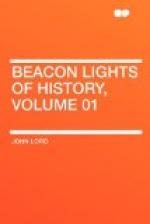There was developed among this primitive and virtuous people a religion essentially different from that of Assyria and Egypt, with which is associated the name of Zoroaster, or Zarathushtra. Who this extraordinary personage was, and when he lived, it is not easy to determine. Some suppose that he did not live at all. It is most probable that he lived in Bactria from 1000 to 1500 B.C.; but all about him is involved in hopeless obscurity.
The Zend-Avesta, or the sacred books of the Persians, are mostly hymns, prayers, and invocations addressed to various deities, among whom Ormazd was regarded as supreme. These poems were first made known to European scholars by Anquetil du Perron, an enthusiastic traveller, a little more than one hundred years ago, and before the laws of Menu were translated by Sir William Jones. What we know about the religion of Persia is chiefly derived from the Zend-Avesta. Zend is the interpretation of the Avesta. The oldest part of these poems is called the Gathas, supposed to have been composed by Zoroaster about the time of Moses.
As all information about Zoroaster personally is unsatisfactory, I proceed to speak of the religion which he is supposed to have given to the Iranians, according to Dr. Martin Haug, the great authority on this subject.
Its peculiar feature was dualism,—two original uncreated principles; one good, the other evil. Both principles were real persons, possessed of will, intelligence, power, consciousness, engaged from all eternity in perpetual contest. The good power was called Ahura-Mazda, and the evil power was called Angro-Mainyus. Ahura-Mazda means the “Much-knowing spirit,” or the All-wise, the All-bountiful, who stood at the head of all that is beneficent in the universe,—“the creator of life,” who made the celestial bodies and the earth, and from whom came all good to man and everlasting happiness. Angro-Mainyus means the black or dark intelligence, the creator of all that is evil, both moral and physical. He had power to blast the earth with barrenness, to produce earthquakes and storms, to inflict disease and death, destroy flocks and the fruits of the earth, excite wars and tumults; in short, to send every form of evil on mankind. Ahura-Mazda had no control over this Power of evil; all he could do was to baffle him.
These two deities who divided the universe between them had each subordinate spirits or genii, who did their will, and assisted in the government of the universe,—corresponding to our idea of angels and demons.
Neither of these supreme deities was represented by the early Iranians under material forms; but in process of time corruption set in, and Magism, or the worship of the elements of Nature, became general. The elements which were worshipped were fire, air, earth, and water. Personal gods, temples, shrines, and images were rejected. But the most common form of worship was that of fire, in Mithra, the genius




